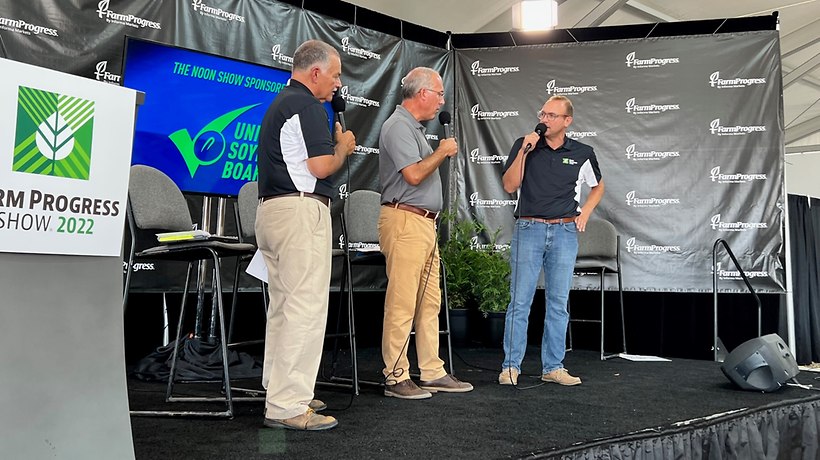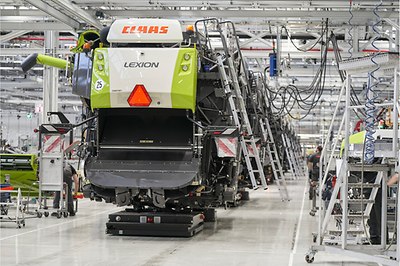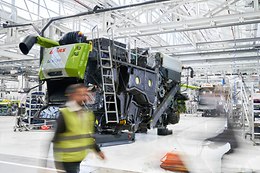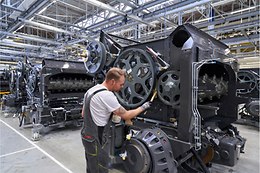


The CLAAS main assembly hall transformed in 4 months.
In 1952, the company’s first self-propelled combine harvester named “HERCULES” rolled off the shiny floors of a brand new production hall in Harsewinkel, Germany. The production facilities, just like the machines it produced, were state-of-the-art. In 1958, the hall was expanded to accommodate the production of the next-generation “HUCKEPACK” combine harvester. New additions followed, offering more and more space for expanding lines of self-propelled equipment, including the JAGUAR forage harvester and XERION tractor.
A final gift from a former Chairman.
About five years ago at the age of 90, Helmut Class walked into the 1950’s era production hall where he sat and observed. He noticed that the production of the large combine harvesters always got stuck at the same point. At less than 14 feet, the height of the old hall was so low that the modern combines had to be routed to a newer part of plant in order to add the engines to the top of the machines. The inefficiencies were clearly slowing production of the combines as well as the other lines.
He was a young man when the hall was first built. The size and number of machines on the line was nothing compared to current volumes. So, shortly after observing the shortcomings of the hall, a feasibility study was conducted to determine solutions for the growing problem.
Until now, combine harvesters in Harsewinkel were built on two assembly lines. As the machines grew larger and incorporated a wider range of options, they presented more and more challenges in the older halls. It was no longer possible to test the grain tank on the LEXION series flagship products in certain areas. Moreover, the launch of the TRION in the summer of 2021 called for a fresh approach: it meant that a future production facility would have to build more combines per day and cater to an increasingly wider range of models – but with greater use of identical parts. The feasibility study concluded that the two separate lines needed to be synchronized into one line.
Synchronizing the two lines.
The synchronized production project coded-named “SynPro2020” took several years of planning, four months of construction, and approximately $47.8 million to complete. Described by the engineering team as “open-heart surgery,” the precisely timed reconstruction project shut down the production lines during the four slowest months of the year in order to cut out the middle section of the plant in July and replace it with a new building three times as high as the old one by November. Needless to say, there was no room for error.
Once the project was complete, the two previously separate assembly lines that cut through the old production hall were transformed into one synchronous production system. Simon Krieter, the 35-year-old in charge of the ongoing modernization project, explains: “Because we are using more identical parts for the basic design of our models than we used to we are able to run on just one line.” On the one hand, the latest generation of combine harvesters are almost all one of a kind, as they are tailored and calibrated to meet each customer’s specific needs. On the other, the fundamental design of the models has been harmonized. This platform-based approach was the key to further expanding the company’s offering to its customers while still maintaining production efficiencies.
Combines are among the most complex agricultural machines to build, with up to 15,000 individual parts each. Even with such complexity, this new assembly process allows for an unprecedented variety of specifications and options on just one line to meet the demands of today’s operators. In fact, the Harsewinkel plant now offers more than 40 different LEXION and TRION variants to uniquely meet customer needs around the world. All TRION combines sold in North America are produced on this line.
Having just one main assembly line increases efficiency, flexibility, and sustainability, so the CLAAS plant can build as many as 28 combine harvesters per day. “Our workflow will be better,” says CLAAS spokesperson Sebastian Griestop. “The pace will increase. And because we have more space, it will be much easier to get ahold of the right tools and materials.”
“It’s an investment in the future, which will bring significant benefits for our customers and employees,” explains Simon Krieter. “The new combine harvester production system will ensure more quality.”
Quality and sustainability
The new CLAAS factory also provides additional quality control with six, ultra-modern tech benches to ensure flawless operation in the field. This is where they’ll perform two rounds of quality control, along with the initial commissioning of the machines.
The team runs through all the mechanical, hydraulic, and electrical functions to check working order, and test electronic features such as CEMOS, CEBIS, GPS PILOT and TELEMATICS.
The new assembly hall is also earth friendly, saving about 470 tons of carbon dioxide per year, thanks to efficient energy management, a superb ventilation system, excellent insulation, and LED lighting.
CLAAS is putting efficiency at the heart of machine advancement from the production line to the field. And, even though Helmut Claas didn’t live to see the project was completed, there is no question that he would have been proud of the final results.



Event calendar
-
DateEvent
-
Jul 25, 2024 - Jul 25, 2024Baltic, SD
-
Aug 27, 2024 - Aug 29, 2024Boone, IA
-
Jul 16, 2024 - Jul 18, 2024Saskatoon, Saskatchewan

















